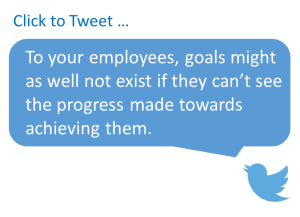You probably already know some of the top methods to increase and retain employee motivation and engagement, such as providing:
- Competitive Compensation
- Challenging and Meaningful Work
- Recognition
- Opportunity Career Advancement (Upward Mobility)
- Community and Social Engagement Activities
If you didn’t already know some of the top employee motivators, now you do. Great! Now that you have the intention to implement these methods within your business, how do you actually do it?
Create Line-of-Sight
One of the simplest definitions for Line-of-Sight comes from HR Expert Ed Crow. He explains Line-of-Sight as a term used to describe when employees know and believe in a business’s strategy, are committed to contributing to it, and know exactly what they need to do to help achieve it.
The best way to start is by creating Line-of-Sight. Create Line-of-Sight like you would any other business objective: set goals, establish metrics and KPIs, analyze the results, and repeat with improvements.
1. Establish and Share Clearly Defined Goals.
Goals provide purpose for progress; the light at the end of the tunnel.
Step one of pretty much any business related endeavor is to set S.M.A.R.T. goals (S.M.A.R.T. = Specific, Measurable, Attainable, Relevant, Timely). I know this may seem elementary, but it’s often helpful to be reminded of the basics before learning and implementing something new.
Some of the components of S.M.A.R.T. are often overlooked, especially Timely, Attainable, and worst of all: Measurable. Next, share the goals and their importance with every team member. Understanding the reasons for achieving goals is essential to employee engagement. The reasons provide a purpose for the work they do every day. Having a purpose, in and of itself, is a strong personal motivator. Most people, especially passionate employees, want to feel as if they’re making a positive difference every day.
2. Determine and Analyze the Right Metrics (KPIs).
Metrics are only useful when the data indicates relevant and actionable information in regards to performance.
Once you have S.M.A.R.T. Goals, determine which metrics show the progress made towards each goal. These are usually referred to as Key Performance Indicators (KPIs). Accurately measuring and tracking KPIs is essential to proving progress and identifying where changes need to occur. Only use KPIs (and sub-metrics) that all contributing parties can accurately and consistently measure. KPIs may include data such as total conversions, conversion rates, cost-per-conversion, hours spent on certain activities, etc.
Conversion, used in the sense above, can be any form of task or goal completion, such as making one sale, producing one product, receiving one top rating, etc. In the end, these add up to achieve your larger goals.
Next, implement systems to collect this data. Usually the easiest way to do this is for employees to input their personal data throughout each day. Examples include recording hours spent on specific projects/clients, number of sales made, amount of products/services sold, amount of projects completed, etc.
3. Ensure Team Members Understand How Their Individual Contributions Affect KPIs.
Every team member should be confident that the effort they put into each working hour has meaning.
Next, map out the plan to reach each KPI with specific tasks assigned to specific individuals or teams. These tasks can be high level, especially if they are turned over to a team, who will then break them down into more specific tasks and delegate further. Delegation is key. Delegation gives employees a sense of ownership and responsibility, instilling a desire to complete tasks to a level that reflects positively on themselves.
After everyone has specific tasks that contribute to specific KPIs and sub-metrics, provide a channel for everyone to record their contribution. This is commonly done in the form of recording hours for specific tasks, amount of items or services sold, financial value of items or services sold, etc.
[Have trouble delegating? Check out The Control Freak’s Guide to Digital Marketing Delegation.]
4. Be Transparent. Display a Progress Dashboard to the Whole Team.
In the eyes of your employees, goals might as well not exist if they can’t see the progress made towards reaching the goals.
Displaying goal progress provides a visual reference that helps team members be motivated about contributing to those goals. This is why it’s important to keep everyone informed on where the team/company is in regards to reaching your goals. Dashboards are the best way to display goal progress. When it comes to dashboards, the simpler the better. Use basic bar charts, line graphs, and pie charts.
5. Regularly Update, Review, and Alter.
Progress inspires more progress, and shortfalls, if addressed positively and proactively, can inspire innovation.
One of the fastest, and most efficient, ways to improve a process is to start making the improvements throughout the process itself. Update your dashboard each week, if not each day. If you have a system that automatically updates the dashboard for you, even better.
Next, schedule a routine meeting to review the dashboard with your team. This time should be used to discuss the data in depth. Call out data from high performing individuals and teams, and have a discussion with everyone regarding the techniques they’re using to achieve the results. Do the same for the low performing individuals and teams, to collaborate on ways to improve their current processes. This method can strengthen the team by allowing everyone to contribute and help each other improve. It also increases the rate at which the goals are achieved, assuming process improvements are made after each dashboard review meeting.
 6. Recognize individuals and teams for positive contributions.
6. Recognize individuals and teams for positive contributions.
Recognition and other incentives can go a long way when it comes to motivating employees.
Make sure your employees feel that their efforts are noticed and appreciated, especially when their delivering outstanding results. How you show your appreciation may vary, but common methods include:
- Public verbal recognition in front of teammates
- A shared token that’s passed on to the top performing individual or team each review period
- Physical trophies or other mementos for individuals and teams to keep
- Financial incentives, such as bonus deposits, prepaid credit cards, or gift cards
- A large prize such as an event or trip for the best performing individuals or teams
[For a sales specific example, check out Sales Incentive Pay Plans for Small Business Salespeople.]
7. Apply what you learned and repeat.
Great, you achieved your shared goals, learned a few lessons, and improved employee engagement. Now, do it again, but this time do it better.
Most people feel a sense of pride and accomplishment when they successfully complete a challenge. When these challenges are overcome as a team, it also strengthens the bond between the team members. After they complete their goal, use that energy to motivate them to accomplish even greater goals. Make sure to record lessons learned, share and have an open dialogue with your team, and apply the best practices to the next set of goals.
Summary
People want to feel that they’ve accomplished something, that their work has meaning, and that other people recognize them for their accomplishments. There are many ways to provide this for your employees, but they all require Line-of-Sight. To successfully execute this, follow the five steps:
- Establish and share clearly defined goals.
- Determine and analyze the right metrics (KPIs).
- Ensure team members understand how their individual contributions affect KPIs.
- Be transparent. Display a progress dashboard to the whole team.
- Regularly update, review, and alter.
- Recognize individuals and teams for positive contributions.
- Apply what you learned and repeat.
[hs_action]








Agree, disagree, or just have something to add?
Leave a comment below.